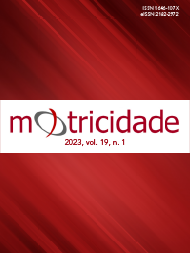Exercise training in children and adolescents with mouth breathing syndrome: a systematic review
DOI:
https://doi.org/10.6063/motricidade.28143Palavras-chave:
Mouth Breathing, Posture, Exercise, ChildrenResumo
The breathing pattern of Mouth Breathing (MB) implies the adaptation of body posture to facilitate the passage of airflow through the oral cavity, which can be prevented or reversed through physical exercise. However, there is no consensus on which is the best model of exercise program to minimise these postural adaptations. The purpose of the review was to investigate the effect of different physical exercise programs on the posture of mouth-breathing children and adolescents. The research was performed in Scopus, PubMed, Lilacs, Bireme, and Scielo databases in November 2022. The following descriptors were included: "mouth breather and exercise", "mouth breathing and exercise", "nasal obstruction and exercise", "mouth breather and exercises", "mouth breathing and exercises", and "nasal obstruction and exercises". Clinical trials related to the effect of physical exercise on the posture of MB children and adolescents were considered. Among 2796 identified studies, six were included. The mean score of the methodological quality scale of the selected studies was 5.5 points on a scale of 0 to 10. All studies showed an improvement in body posture after the exercise program. The exercise programs comprised muscle strengthening and stretching exercises, neuromuscular proprioceptive facilitation, and postural and diaphragmatic reeducation. The duration of the programs and the weekly frequency varied in the studies. Although it is difficult to compare studies and establish guidelines for formulating an exercise protocol, it was observed that upper limb strengthening and stretching exercises could effectively improve the body posture of MB children and adolescents.
Downloads
Publicado
Edição
Secção
Licença
Os autores dos manuscritos submetidos para publicação deverão ceder, a título integral e permanente, os direitos de autor (copyright) à revista Motricidade e às Edições Desafio Singular. A cedência de direitos de autor permite a publicação e divulgação do artigo em formato impresso ou eletrónico e entrará em vigor a partir da data de aceitação do manuscrito. Os autores concedem, ainda, os direitos para a revista Motricidade utilizar e explorar o respetivo artigo, nomeadamente para licenciar, ceder ou vender o seu conteúdo a bases de resumos/indexação ou outras entidades.
Nos termos da licença “Creative Commons”, os autores poderão reproduzir um número razoável de exemplares para uso pessoal ou profissional, mas sem fins comerciais. Nos termos da licença SHERPA/RoMEO, os autores poderão, ainda, disponibilizar/arquivar uma cópia digital final (versão postprint) do artigo no seu website ou no repositório científico da sua instituição.

